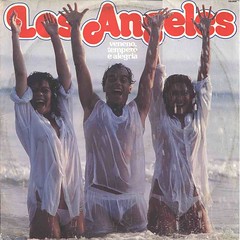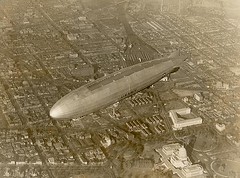Filmmaker Michael Reich and Videothing feature, LA Weekly
Also: Target Video, TV Party, and video art vs. the music video
Converse and a camera: A still from an online arbiter. Photo by Rena Kosnett
TV party tonight: Michael Reich's Videothing.com Captures the Essence of L.A.'s Underground
By RENA KOSNETT
Wednesday, June 4, 2008 - 3:15 pm
There’s something funny you notice when first visiting videothing.com, the Web site for filmmaker Michael Reich’s local music project, Videothing: Nothing is for sale. Reich’s brief, sharply edited, somewhat scripted but mostly spontaneous films of music performances, band interviews, tour clips and general eccentricities, such as a Health and AIDS Wolf at the Smell, Matt Fishbeck playing his Omnichord over a toilet, and a rambling Jamai-can’t-accented speech about reggae from Ari Up, are laid out in two clean, colorful, user-friendly columns down the length of Videothing’s home page.
This is an inkling of what sets Videothing apart from the recently launched Pitchfork.tv, or Vice’s year-old online channel, VBS TV. In all cases, the content is free, immediate and accessible; but Videothing’s sole objective is to get you to watch the content. Not to buy an album, a festival ticket or the latest T-shirt style from American Apparel.
This puts Videothing more in the realm of an anarcho-punk zine than that of MTV. Videothing.com’s block colors and dark background took cues from the covers of Soul Jazz Records’ New York Noise compilations of experimental no-wave punk music that originally came out on small DIY labels from 1978 to 1988. The same East Coast music and art scene birthed another of Reich’s major artistic inspirations: Glenn O’Brien’s quasi-political New York cable-access show TV Party, which had the tag line, “TV Party is the show that’s a cocktail party but which could also be a political party.” TV Party ran from 1978 to 1982 and made regular guests of Debbie Harry, Mick Jones and Jean-Michel Basquiat. The scratchy Xerox aesthetic of the VHS and cassette-tape faces on Videothing.com is Reich’s inspirational reference to this era of nonproprietary art making, a moment that was more about the sharing of ideas than the copyright of a song. Says Reich: “In that scene, people would make homemade VHS tapes to trade like video zines, but now we get that kind of accessibility on the Internet.”
Each film’s length is determined by Reich’s self-proclaimed attention-deficit disorder, which, he says, is also the reason for his sharp editing style. Most likely because of his background in 2-D art, the power of suggestion — which is commonly expounded upon by figure-drawing and painting teachers — plays largely into Reich’s editing. In the “Crystal Antlers Go to Texas” video, which was shot during the first day of Reich’s hitching a ride to SXSW with the Long Beach band, quick sequential loading-gear/getting-gas/ Mom-closing-the-van-door clips are followed by hand-scribbled titles shot over a few seconds of Dylan and the Band’s “This Wheel’s on Fire.” Besides the British Absolutely Fabulous characters Patsy and Edina, “This Wheel’s on Fire” has become an archetypal song for the struggling on-the-road musician, in part, because of its lyrics about packing, waiting and rolling down the road, but also because of Levon Helm’s autobiography of the same name — and it just happened to be on the mix Crystal Antlers vocalist Jonny Bell made for the trip.
These are the kinds of circumstantial subtleties that make Videothing special. Reich, who also achieved a small level of fame without showing his face as “Hero Robot No. 2” in Daft Punk’s Electroma, is keen to his surroundings and can capture interesting moments without having to dwell on them. A quick toss of room service trays onto a hotel room carpet in Austin, Texas, is all the viewer needs in order to understand Reich’s mood at the beginning of his “On a Bridge” SXSW video: underslept, aggressive and juvenile. Not surprisingly, that particular video is even more clipped than usual, includes a (mild) confrontation with the police, and ends after a few seconds of No Age’s playing, when a crowd surfer slams into the camera lens.
Getting kicked in the face while holding video equipment was also a favorite pastime of filmmaker Joe Rees. With his San Francisco–based operation, Target Video, Rees was the West Coast’s answer to TV Party, bringing punk groups into his studio or orchestrating bizarre shows, the most oft-talked-about being 1978’s The Cramps: Live at Napa State Mental Hospital, during which female patients swarm around Lux Interior as he croons, “Somebody told me you people are crazy, but I’m not so sure about that.”
This year, Target Video was officially snuggled into the bosom of a fine-art institution when it was included in the Getty’s “California Video” exhibition, a generous group show that traced the significant developments of video art in California, and included heavyweights Eleanor Antin, Mike Kelley, John Baldessari, Martin Kersels and eccentric tag team Harry Dodge and Stanya Kahn. The valley that separates video art and promotional music videos is vast — the former started in the 1960s as a way for artists to use time as a canvas, while the latter, despite the creativity of directors like Spike Jonze and Michel Gondry, are promotional tools. But the resurfacing of music-video art has allowed for crossover between the two genres and can lead to strong differences of opinion. (Getty curator Glenn Phillips believes that Joe Rees’ Target Video has artistic merit, while L. A. Weekly art critic Doug Harvey does not: “... Conspicuous in its absence, especially considering the inclusion of such nonartsy material as the S.F. punk archives of Target Video ...”)
At its core, though, intent is what divides music video art from the music video, which Reich understands. As a paying gig, Reich directs full-production music videos (for, among others, the Shins, Bad Religion and the Brazilian Girls) for Draw Pictures, a commercial film agency with offices in London and Los Angeles. With client-based work, Reich is employed to help sell a product; with Videothing, he is trying to increase awareness of a culture and contextualize the live music within the realm of the club, or toilet, or bus. He’s making it not just for the band but for the people who were there, for the people who couldn’t make it and for his own enjoyment. “We’re all in this together,” he says. “That’s why I never get when bands give me a hard time about doing a five-minute interview. This one night, I waited until 3 or 4 a.m. to get an interview with Japanther. I ended up having to help them load up their gear, which I didn’t mind. But then this one guy in the band said, ‘If we’re gonna do this, you have to go get us some water.’ So I had to drop what I was doing to go find a liquor store and buy them bottled water. Later, though, they e-mailed me to say thank you.”
Because Reich makes these cool little films as his own project, Videothing’s recognizable cardboard signs and duct-tape labels were the handiest way to assemble a portable film set on the cheap. Also, it is just more realistic to carry around a backpack full of poster board signs and vinyl letters while roaming the streets of Austin and Los Angeles rather than a suitcase full of the props he originally used, like the large stuffed tigers he bought for the “Lady Tigre” video. “Basically, the signs came from Bob Dylan and not having enough money, and the desire to make 2-D art again,” Reich explains. The London alley in which D.A. Pennebaker shot a young Dylan dropping paper signs to the beat of “Subterranean Homesick Blues” does look like it could be along the entrance to the Smell, if beats Allen Ginsberg and Bob Neuwirth were replaced with Daniel, downtown L.A.’s most famous bum-security guard.
Target Video screens at MOCA on June 7, and Videothing can be seen in action, out and about, on most nights in Los Angeles, and on the Web site www.videothing.com.
AIDS Wolf in London by Videothing
The Cramps at Napa State Mental Hospital by Target Video
David Byrne on TV Party
Pennebaker
Wednesday, September 10, 2008
VIDEOTHING feature
Subscribe to:
Post Comments (Atom)




1 comment:
Awesome! Great article!
Post a Comment